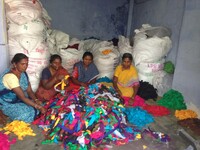India
HomeNet South Asia (HNSA) recently organised an engaging regional webinar titled ‘Access to Markets’ on 29 April 2025, bringing together affiliate organisations from all across South Asia to discuss...
Payalben Hiteshbhai Ranat, a home-based worker from Isanpur, Ahmedabad, truly embodies the phrase, "Be the change you wish to see."
In September 2019, with support from Comic Relief, HomeNet South Asia and WIEGO collaborated on the Power Up programme. It was designed to create a global movement of home-based workers by...
HNSA is implementing the European Union’s co-funded “Hidden Homeworkers” project across India, Nepal and Pakistan. Within this project, wage cards were developed and distributed by HNSA grassroots...
The Eastern Himalayas straddle three South Asian nations, Nepal, India, and Bhutan, which also happen to be the main producers of large cardamom, a specialty spice that enjoys wide appeal across South...
How A Grassroot-Level Organiser, In Ahmedabad, India, Gave Up Her Daily Wages In Order To Organise Her Community And Link Them To Basic Services. Ramilaben lives in a crowded settlement of over 300...
As a result of the Covid-19 pandemic, the country went into lockdown on 24th March, resulting in a widespread humanitarian crisis for the many informal workers stranded without work or shelter, for...
New Delhi – India’s capital – is battling a particularly rough 2020. In February, 2020, riots broke out in large parts of the city. And just while the capital was limping back to normalcy, COVID-19...
Between 2011-12 and 2017-18, the number of home-based workers decreased significantly. The drop was greater than the drop in India’s total employment and was largely due to the significant decrease in...
The spread of COVID-19 across South Asia has resulted in the large-scale shutdown of business operations. While almost all industries have been adversely affected, the garment industry is one of the...
The Second Draft Code on Social Security (2018) Vs The Third Draft Code on Social Security (2019) - A Comparison From the Perspective of Unorganised Sector Workers.
The terms ‘invisible’ or ‘hidden’ are often used when referring to women homeworkers in garment and footwear supply chains. Their work is often undervalued and remains unseen by the retailers and...
This year, the Australian Open brought cheer to India’s leading garment hub – Tiruppur. The Hindu, a national daily, reported that ball boys and girls along with courtside statisticians, at the...
This report is the outcome of a study titled ‘Impact of Demonetization on Home-based Workers of Jaipur and Mumbai’ commissioned by WIEGO in February 2017. It is part of a larger study, which...
Home-based workers produce goods or services for the market from within or around their own homes. In developed, developing and under-developed economies, they produce a wide range of low-and high-end...
India’s growth story is a paradox. While India has seen impressive growth in its Gross Domestic Product and per capita income, these gains have not been evenly distributed.
How A Social Enterprise In Udaipur Organises And Links Home-Based Workers To Global Supply Chains It was a quiet day, when we arrived, in Kamli Ka Guda. The expansive highways that stretch out of...
The Government of India is committed to inclusive growth, where the benefits of development also reach the last person in the remotest village or most inaccessible informal urban habitation of India.
The Homebased Workers Policy workshop was held on 7th and 8th March 2017, at India Habitat Centre, New Delhi and attended by participants at Annexe 1. The agenda is at Annexe 2.






























